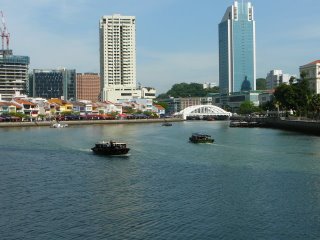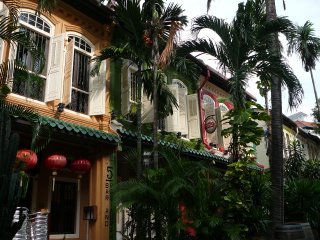 Singapore is beautiful, it reminds me exactly of Cincinnati in the summer--just more languages and a much better transportation system!
Singapore is beautiful, it reminds me exactly of Cincinnati in the summer--just more languages and a much better transportation system! 
Enjoy our travels to Taipei and points east. Two "retired" bears off on a spree!
 These are some of the famous Singaporean shophouses on Emerald Road. They are being gentrified after a period of neglect all over the city. Each was quite different and the inhabitants quite like DC folk, they know they are "local color" and are friendly and patient with the hoards of gawkers on their residential street!
These are some of the famous Singaporean shophouses on Emerald Road. They are being gentrified after a period of neglect all over the city. Each was quite different and the inhabitants quite like DC folk, they know they are "local color" and are friendly and patient with the hoards of gawkers on their residential street! 


 Here are the kids who went. Strings, piano, choral, band, and art. They have four days of adjudication, workshops, and performances with international artists. Bill was glued to the school the whole time. Singapore is so easy to negotiate that even though I was alone the whole time, I had no trouble at all getting all over the city--albeit at a dead run to take in as much as I could, guidebook and camera in hand!
Here are the kids who went. Strings, piano, choral, band, and art. They have four days of adjudication, workshops, and performances with international artists. Bill was glued to the school the whole time. Singapore is so easy to negotiate that even though I was alone the whole time, I had no trouble at all getting all over the city--albeit at a dead run to take in as much as I could, guidebook and camera in hand! 


 This is one of their challenges and much harder than it looks! The bars become progressively further apart and wobble as they are not fixed, but they have to find a way to the top helping each other. Happily, although it can take 30-45 minutes to do so, all our teams made it up, which several groups didn't, and one set of girls and one set of boys set new time records....
This is one of their challenges and much harder than it looks! The bars become progressively further apart and wobble as they are not fixed, but they have to find a way to the top helping each other. Happily, although it can take 30-45 minutes to do so, all our teams made it up, which several groups didn't, and one set of girls and one set of boys set new time records.... 
 Counselors' tent aka The Cocoon, others were Crustacean Corner, Magpies Roost, Squirrel Nest, Bee Hive, etc....toilets and showers harbored various beasties and slitheries, but overlooked a beautiful stream and had handmade pottery sinks, you couldn't beat the view -- when you could see it through the rain!
Counselors' tent aka The Cocoon, others were Crustacean Corner, Magpies Roost, Squirrel Nest, Bee Hive, etc....toilets and showers harbored various beasties and slitheries, but overlooked a beautiful stream and had handmade pottery sinks, you couldn't beat the view -- when you could see it through the rain! 